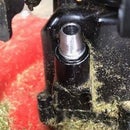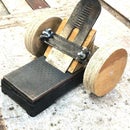Introduction: Industrial Strength Electronics Holster
This is a wireless microphone sender unit in a tough waist holster I made for it. As a parish pastor, I use this at least once a week. You may not use a wireless microphone, but this holster could be for any piece of electronics you might want to wear on your belt, including a cell phone. In the case of a cell phone, you may want to add extra ribs to cradle the phone. I used only one lateral loop around the upper portion of the sender unit and one vertical loop that passes around the unit from below.
Step 1: The Factory Belt Clip
This photo shows the factory issue spring wire belt clip. It has the fiendish proclivity to disengage from the sender unit and fling itself across the room when I remove the sender from my belt.
Step 2: Raw Material
Friends built a garage. They gave me a couple of pounds of concrete reinforcement wires. Each is about 1/8 inch thick and 5 inches long. Some are straight, but some have a spiral twist in them. I used about four stubs in this project.
Step 3: Remove the Twist and Make Straight
Removing the twist is easy. Rotate each twisted stub slowly while pounding on it against a flat iron surface with a hammer. In a very short time the twist is removed and the pieces are quite straight. In the photo you can see that the left half of the stub is now straight.
Step 4: Bend the Belt Loop
I placed a piece of water pipe into my vise and bent one of the stubs around it to make the belt loop. Try to make the bend so the ends are even with each other. Corrections can be made by bending a little more on the long side and straightening a little on the short side.
Step 5: Prepare to Make a Right Angle Bend
Place the ends into the jaws of a vise about 1/4 inch. Try to get the amount inserted equal on each end. Tighten the vise.
Step 6: Bend
Bend the loop over to make a 90 degree angle.
Step 7: Prepare to Weld
This electronics holster requires welding. It would be possible to weld it with a stick welder. In that case, consult this Instructable first so you can begin the arc exactly where you want it to begin. It is much easier just to use a wire feed welder, if that option is available to you.
A good setup makes good welds much easier. I used a piece of aluminum angle and spring clamps. This setup holds the parts in their desired orientation and makes precise welding very easy. Weld from both sides of each joint where the pieces overlap.
The straight piece is for illustration purposes only. When I made this holster I bent the stub to fit around the circumference of the sender unit before preparing to weld it to the belt loop.
Step 8: The 2nd Set of Welds
This is the setup I used for welding the vertical loop to the horizontal loop.
Step 9: Grind the Welds
I ground the welds flat so they would not obstruct the sender unit when I slip it into the holster. I used a Dremel tool with a grinding stone.
Step 10: Make It Fit
Unless you are very, very good; the holster may be a little too loose or a little too tight for your piece of electronics. I solved that problem by squeezing the loose area a little in a vise. See the first photo. If the holster was a little too tight or I squeezed too much, I opened the holster a little by prying with a claw hammer and a large screwdriver. See the second photo. The wireless microphone sender does not have any display screen to protect, so I did not worry about any scuff marks. If that is a consideration, the steel stub wires could be wrapped with electrical tape to protect your electronics.
This holster has worked very well for its intended purpose. I did check for cell phone holsters in a local store. The nearest thing to what I needed was a very feminine pink. I opted for this more industrial look.
Step 11: Adapted for My Cell Phone
After knife141 commented that he wanted to make one of these for his cell phone I began to think how nice it would be to have fewer things in my shirt pocket. I decided to make one of these holsters custom fitted for my cell phone. The basic structure is the same, but I added a rib on each side near the bottom to keep the phone from cocking to one side and slipping out of the bottom. After a day or two of wearing this holster I noticed it could slip off of my belt while sitting on a sofa and I could lose my phone. I added a piece to thicken the very bottom part of the clip or belt loop. See the second photo. It is a little more difficult to put the holster onto my belt afterward, but it is certain not to slip off now.













